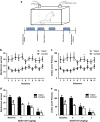The GABAB Positive Allosteric Modulator ADX71441 Attenuates Alcohol Self-Administration and Relapse to Alcohol Seeking in Rats
- PMID: 28294133
- PMCID: PMC5520784
- DOI: 10.1038/npp.2017.53
The GABAB Positive Allosteric Modulator ADX71441 Attenuates Alcohol Self-Administration and Relapse to Alcohol Seeking in Rats
Abstract
GABAergic signaling is involved in modulating the reinforcing properties of alcohol, and GABAB receptors have been proposed as a potential target for clinical treatment of alcoholism. The orthosteric GABAB receptor agonist baclofen has been shown to suppress operant self-administration of alcohol in animals and alcohol use in alcohol-dependent patients, but its utility is limited by a narrow therapeutic index. We tested the effects of ADX71441, a novel GABAB receptor positive allosteric modulator, on alcohol-related behaviors in rats. We first assessed the effects of ADX71441 (1, 3, 10 and 30 mg/kg, I.P.) on both non-dependent and dependent male Wistar rats trained to self-administer 20% alcohol. We then determined the effects of ADX71441 on stress-induced as well as cue-induced relapse-like behavior. Finally, we sought to identify the brain regions through which ADX71441 may act to prevent relapse-like behavior by mapping the neuronal activation induced by stress-induced reinstatement of alcohol-seeking using c-Fos immunohistochemistry. ADX71441 dose-dependently decreased alcohol self-administration of both dependent and non-dependent animals, but its potency was higher in alcohol-dependent rats. Furthermore, both cue- and stress-induced alcohol seeking were blocked by the GABAB receptor positive allosteric modulator. Finally, pretreatment with 3 mg/kg of ADX71441 before stress-induced reinstatement significantly decreased c-Fos expression in a network of brain regions implicated in stress-induced relapse, comprising the nucleus accumbens shell, the dorsal raphe nucleus and the medial prefrontal cortex. Our findings support a causal role of GABAB receptors in alcohol reinforcement and relapse to alcohol seeking. These effects are observed in the absence of significant sedative side effects. Jointly, these observations indicate that GABAB receptor positive allosteric modulators merit being tested clinically for the treatment of alcoholism. Our data also point to a potential biomarker of target engagement for early clinical studies.
Figures





References
-
- Addolorato G, Caputo F, Capristo E, Domenicali M, Bernardi M, Janiri L et al (2002. a). Baclofen efficacy in reducing alcohol craving and intake: a preliminary double-blind randomized controlled study. Alcohol Alcohol 37: 504–508. - PubMed
-
- Addolorato G, Caputo F, Capristo E, Janiri L, Bernardi M, Agabio R et al (2002. b). Rapid suppression of alcohol withdrawal syndrome by baclofen. Am J Med 112: 226–229. - PubMed
-
- Addolorato G, Leggio L, Cardone S, Ferrulli A, Gasbarrini G (2009). Role of the GABA(B) receptor system in alcoholism and stress: focus on clinical studies and treatment perspectives. Alcohol 43: 559–563. - PubMed
-
- Addolorato G, Leggio L, Ferrulli A, Cardone S, Vonghia L, Mirijello A et al (2007). Effectiveness and safety of baclofen for maintenance of alcohol abstinence in alcohol-dependent patients with liver cirrhosis: randomised, double-blind controlled study. Lancet 370: 1915–1922. - PubMed
-
- Anstrom KK, Cromwell HC, Markowski T, Woodward DJ (2003). Effect of baclofen on alcohol and sucrose self-administration in rats. Alcohol Clin Exp Res 27: 900–908. - PubMed
MeSH terms
Substances
LinkOut - more resources
Full Text Sources
Other Literature Sources
Medical

